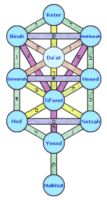Shofar and String Theory: Unfolding the Folded Dimensions
I. Introduction Every year on Rosh HaShanah, the raw, unarticulated cry of the shofar cuts through silence. For Kabbalah, that cry is not mere ritual
I. Introduction Every year on Rosh HaShanah, the raw, unarticulated cry of the shofar cuts through silence. For Kabbalah, that cry is not mere ritual
By Alexander Poltorak The Tree of Life and the Tree of Knowledge as Metaphors for the Wave Function and Measurement Summary This essay proposes a
Structurally identical biblical accounts of creation, destruction, and restoration are viewed as a manifestation of dialectic triad thesis-antithesis-synthesis.

This is the fourth installment in the series of essays on the nature of the soul. The first three installments can be found here: What

…[H]e who tries to cure the soul, wishing to improve the moral qualities, must have a knowledge of the soul in its totality and

In the biblical story of the creation of Adam, the Torah states: Then the Eternal G‑d formed man of the dust of the ground, and

As we discussed in the earlier post, The Tree of Knowledge as a Metaphor for Superposition of States and Heisenberg’s Uncertainty Principle, the Heisenberg uncertainty

And the Lord appeared unto him in the plains of Mamre, as he sat in the entrance of the tent in the heat of the

Meditations on the Maaseh Merkavah – IV This is the fourth and the final installment in the series of posts related to Ezekiel’s prophesy, Ma’aseh

Meditations on the Maaseh Merkavah – I We do science by studying nature. We study physics in a lab, peering into space or working out

The Special Theory of Relativity, published by Albert Einstein in 1905, was a game changer. It ushered the era of new physics dubbed by some

And Moses turned, and went down from the mount, with the two tablets of the testimony in his hand; tablets that were written on both

As I wrote in my post, Schrödinger Menorah: Burning And Not Burning, the Lubavitcher Rebbe, Rabbi Menachem Mendel Schneerson, explains the miracle of Chanukah as
And these are the years of the life of Ishmael: one hundred years and thirty years and seven years (Gen. 25,17) You might say the
In the Torah portion Emor (Leviticus 21:1–24:23), we are instructed to abstain from work every seventh day on Shabbat. Next week’s Torah portion, Behar, continues
Last week Torah portion, Emor, speaks about the prohibition of working on Shabbat. In fact, the Talmud enumerates precisely 39 categories of labor forbidden on
We all know that we leave in a three-dimensional world. Up-down, right-left, forward-backward – these are well-familiar to us directions in three dimensions of space

In this Torah portion, Devarim (Deuteronomy 1-3), Moses recalls the travels through the Sinai desert when G‑d told him: Be not at enmity with Moab,

These are the journeys of the children of Israel… (Numbers 33:1) When G-d brought the Jews out from Egypt, He brought them out with the mystery of
Do you like riddles? Here is a riddle – what do these two figures represent in the context of Exodus? No Idea? How about

There is a continuous thread about the mastery of time that weaves through the last chapters of the book of Genesis (Bereshit) and continues through
Presented at the International Torah and Science Conference in Miami International University on December 18, 2005 Alexander Poltorak Introduction. This is the third in